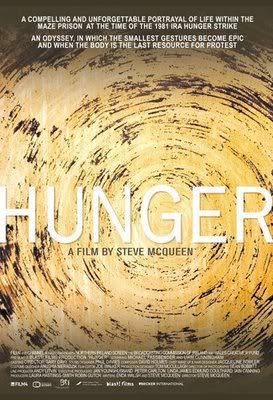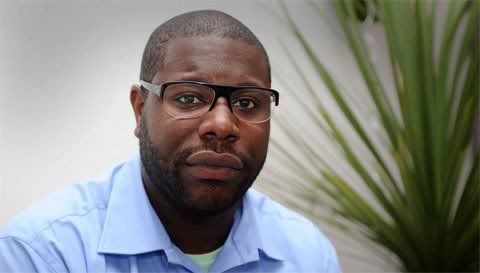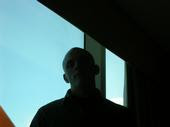
Pride may not be the real issue here, but there's a certain amount of stock I hold dearly within my fortitude to handle films that "go there." That leave no image of brutality unseen, drop the gauntlet of good taste down fast in order to leave it shattered on the sticky cineplex floor. My stomach is deep, full of room for such harsh visions. So whenever a movie sneak attacks me and leaves me feeling queasy, I have no choice but to stand up and salute. Wave the white flag in the filmmakers' direction. The only time I can recall actually closing my eyes during a scene was when I first saw Inside at Lincoln Center, specifically the infamous-in-these-parts scissors scene at the end. One eye was half open, the other's lid pressed firmly atop the socket, unable to look away. It was a truly harrowing experience.

Steve McQueen
Having just watched Steve McQueen's unbelievably raw Hunger at the IFC Center, I can now shamelessly say that a movie has left me feeling nauseous like I've never felt before, regardless of the setting or my physical/health state. One sequence in particular had this effect, a single take tour-de-force that places the viewer in the midst of some of the fiercest, most inhuman police brutality imaginable. In a TKTK prison in Northern Ireland, back in 1981 (Hunger is based on true events), the British government has imprisoned dozens of Irish "political terrorists" who refuse to obey the Brits' law. The prisoners are on a "no wash" strike, meaning they're all filthy by choice, the walls of their cells caked in hardened, smeared feces. In an effort to enforce their methods with blunt precision, a slew of cops in full armored suits line in a hallway, shields before them and nightsticks in hand. In a bit of ritualistic pounding, they all begin to beat their sticks on the shields. Then, each prisoner is yanked out of their cells, naked, and thrown through the gauntlet of cops, who all take violent swings with their nightsticks as the nude inmate crawls through for survival. Once at the end of the hell-way, each beaten man is violated anally and then left to rot on the floor.

McQueen shoots the scene in one long take, and it's pretty breathtaking. Until this point, Hunger is a rather subdued, controlled film, moving along patiently with little dialogue and plenty of drawn-out in-cell scenes. That's why this police-imposed, one-sided riot is so unnerving. McQueen swoops the camera from prisoner to prisoner throughout the scene, erratic with his hands. Whatever feeling of ease the viewer has had is immediately swallowed up and spit out as if a T-Rex is doing the oral flinging.
I felt the bottom of my throat give out a bit, and the scene wasn't even halfway over. Crazy.
For a first time filmmaker, McQueen achives nothing short of a gargantuan effort with Hunger. Scene after scene, the film is an exhibition of the man's visual gifts. Directly after that aforementioned prison beatdown setpiece, we follow one of the prison's high-ranking officers as he visits his sick mother in a nursing home. It's obviously an attempt to make the viewer sympathize a bit with the mongrels in blue. But then, like the robber who sucker-punches McLovin in Superbad, we're hit with a point-blank execution that I totally didn't see coming. At all. As a result, McQueen had me second guessing his every subsequent move. I was basically the guy's puppet, a plaything that he could trick and blindside however he pleased cinematically.
Fortunately for my senses, the remainder of the film is devoid of random violence. Well, actually, "fortunately" isn't the right word. While never less than stunning, the final act of Hunger is tough to watch without cringing a tad. At this point, our lead, Bobby Sands (played amazingly by Michael Fassbender, who impressed in Eden Lake and will surely impress in Quentin Tarantino's Inglourious Basterds; the guy is one to watch), has decided to kick his freedom-fighting into high gear by organizing a hunger strike within the prison, which 74 other inmates agree to. Now, I'm not sure if what we see from here on out is actually Fassbender, or just some incredibly realistic trickery by McQueen and his cohorts. But if you thought Christian Bale looked sickly in The Machinist, you haven't seen a damn thing yet. Fassbender turns into a breathing skeleton, rib-cage sticking out, every other bone excruciatingly visible. Sands lasted 66 days before succumbing to the emaciation, and if dying of hunger is even half as unbearable and painful as seen on Fassbender here, I'm taking my ass to Outback for lunch tomorrow just to make sure I'm well fed. Damn, does it look like almighty hell.

Michael Fassbender, pre-hunger pains
It's films like Hunger that remind me why I'm so infatuated with cinema, which makes it all the more shameful that it's only playing in one theater in this area. Going largely unknown, looked over, outside of film buffs and critics. Something this delicately made, richly acted, and historically significant deserves a chance, so whenever the DVD streets I highly recommend giving it a go. You might toss up your cheeseburger while watching, but there's no doubt in my mind that you'll finish the film feeling floored. Pedal to the emotional metal.
Put it this way: any film that can turn an overlong scene where a guy mops an entire prison hallway into an intensely hypnotic event isn't fucking around.




No comments:
Post a Comment